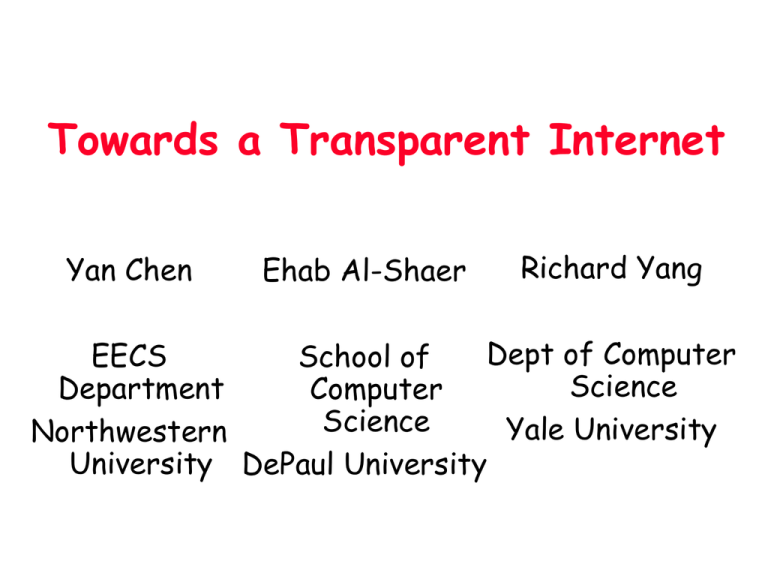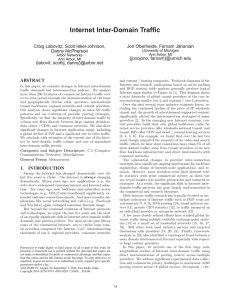TransparentInternet - Computer Science Division
advertisement

Towards a Transparent Internet Yan Chen Ehab Al-Shaer Richard Yang Dept of Computer EECS School of Science Department Computer Science Yale University Northwestern University DePaul University Short Bios • Yan Chen – – – – Assistant professor of Northwestern Univ. DOE CAREER Award in 2005 Microsoft Trustworthy Computing Award in 2004 & 2005 TPC co-chair of IWQoS 07, PC for Infocom, Mobicom, etc. • Ehab Al-Shaer: – Associate professor and Director of MNLAB – Very actively involved in the area of network operation and management for more than 10 years. – TPC co-chair of IM’07, the premier network management conference. PC for INFOCOM, ICNP, IM/NOMS, ASIACCS Motivations • The Internet has evolved to become a uncooperative ossificated network of networks – Network has to be treated as a blackbox » Performance of even neighboring networks are opaque » Inter-domain routing based on policies but not performance » Have to resort to overlay networks which are suboptimal – Diagnosis and fault location extremely hard • Network config management error-prone & expensive – Reactive configurations: tune after deployment – Vulnerable: manually handled and subject to conflicts – Imperative & fragmented: need to access several specific devices in order to implement a service goal Proposed Solution: Transparent Internet • Every network shares its measurement and management information with other networks when necessary (glass box) – Performance: delay, loss, available bandwidth, etc. » Can be at link-level – Management info » Configurations: QoS setting, traffic policing, firewalls, etc. – Traffic info: traffic matrices, traffic characteristics • Information sharing through – As part of the inter-domain protocols: Transparent Gateway Protocols (TGP) – Other applications: leverage DHT Analogy to the Airline Alliance • When airlines compose multi-lag flights, they need more than just route info – Type of aircraft, # of vacancies, probability of punctuation, etc. • Such open model is mutual beneficial – Provide the best flight composition for clients – Similarly, open network model can provide best communications for applications Objectives I Provides a completely transparent view of the Internet to networks and applications • Diagnosis & trouble shooting becomes extremely easy – No more Internet tomography needed • Flexible inter-domain routing – Not just based on policy or # of AS/hops – Flexible metrics based on bandwidth, latency, etc. • Global traffic engineering – Each AS performs its own local traffic engineering – Provide AS path-level routing guide • Unified framework that applications query (push/pull) info as needed – Streaming media, content distribution – Anomaly/security applications Objectives II Provides an autonomic, provable and proactive configuration management • Proactive verification: configuration verified and translated to different vendor specific devices • Proactive validation: Test the configuration changes on archived network traffic without interrupting the operation networks • Autonomic configuration: from high-level “management objectives” to configuration parameters – Configurations are auto-tuned dynamically to achieve the “objectives” Auto-tuning & Proactivity Deploying defining Verifying Validation Evaluation/ Prediction Optimizing Flexible Inter-domain Routing • Multiple routing paths with TGP – Incorporate measurement info into AS paths – Bandwidth-intensive and latency-intensive applications can take different AS paths. • Challenge: inter-domain routing based on bandwidth without making reservation • Solution: Discretize the bandwidth for good tradeoff b/t adaptation and stability – Though stability is a classical problem, not unique to TGP Global Traffic Engineering (TE) • For the current Internet, TE is executed in each AS -- thus only local optimum is achieved – Allowing the network to handle all traffic patterns possible, within the networks ingress-egress capacity constraints (e.g. two phase routing) • With global information, we can potentially achieve global optimum (or Nash equilibrium) – Each AS is a selfish individual – A center (or each AS) infers the Nash equilibrium – Each AS can try the Nash equilibrium, or attempt to benefit itself based on the inferred Nash equilibrium Example of Benefit of Global TE 1G traffic to AS 1 AS 4 AS 2 AS 5 AS 1 AS 3 1G traffic to AS 1 Example of Benefit of Global TE • Without Global TE 1G traffic to AS 1 AS 4 AS 2 AS 5 AS 1 AS 3 1G traffic to AS 1 Example of Benefit of Global TE • With Global TE 1G traffic to AS 1 AS 4 AS 2 AS 5 AS 1 AS 3 1G traffic to AS 1 Unified Transparency Framework for Various Functionality • Sharing of anomaly/security-related measurement – Various characteristics of traffic: heavy hitter, heavy changes, histogram, etc. – Self-diagnosis to survivability • Adaptations – Routing adaptations at router level or application level Practical Issues and Solutions • Incentives for information sharing – Mandatory for next-generation Internet ? – Alliance model for incremental growth • Security/cheating: Trust but verify – Trust most of the info shared but periodically verify » Much easier than the current Internet tomography unless many ASes collude – Verification part of the protocol » Some fields in the packet headers designed for that purpose Summary • Transparent Internet revolutionalizes the black box networks to “glass box” • Enable/improve many functionalities – – – – Diagnosis and trouble shooting over global Internet Flexible Inter-domain routing Global traffic engineering Provable and proactive configuration management to verify, validate and self-tune configuration without interrupting the main operation networks Backup Materials Summary • Configuring the current Internet is highly complex, improvable and passive • Our approach provide a fully proactive/autonomic configuration architecture to verify, validate and self-tune configuration without interrupting the main operation network • Our architecture uses on high-level goal-oriented policy refinement approach Objectives (cont.) Provides a provable and proactive configuration for NGI • Automated Configuration Management: from high-level “management objectives” to configuration parameters – Allow “Sami” to access all web servers except the ones in the “accounting” department – QoS configuration is highly complex: FQ, shapers, RED classes • Correct and Seamless network-wide configuration – Creating a unified configuration representation and verifying the mapping – Conflict detection and resolution • Set-and-Test configuration validation framework – Specially important for mission critical network – Very useful for delay-sensitive application • Self-managed Internet – Autonomic Configuration: configurations are auto-tuned dynamically to achieve the “objectives” – Proactive Configuration: configurations are auto-steered dynamically to avoid predicted problems • Searchable MIBs Configuration – using tagged MIB objects of meta-data and semantic web to provide (1) “multi-view” configuration management and (2) MIB information fusion Technical Approach: Major Security policy verification components includes (1) Policy modeling: BDD representation for all network security policy (2) Consistency checking of global network polices (2) Goal-oriented verification: verifying certain user-defined service properties (4) Policy aggregation and translation to high-level-language and distribution High Level Security Definition Language what Global Configuration Query Language Goal-oriented Security Policy Policy Tactics how FW Router IPSec UPR UPR UPR Aggregation Global UPR Goal Oriented Verification Policy Segmentation Policy Translation & Distribution FW Router IPSec IDS/ IPS Access Point Consistency Check Policy translation validation • Configuration Definition and Verification Architecture (3) Autonomic Programmable Network Control AS3 Reasoning Symptoms AS4 Policies H AS2 AS5 AS1 Diagnose Actions Action selection Feedback (Symptoms) PSA=problem-symptom-action Evaluation Reporting/Visualization Tools PSA Model Autonomic Programmable Network Control Policies PSA Model Problem Reasoning Reporting/Visualization Tools Symptoms AS3 AS4 AS2 AS5 AS1 Diagnose Actions Feedback (Symptoms) Measurement Info to Share • Basic metrics – Delay, loss rate, capacity, available bandwidth – Demand (or traffic volume) and application types • Intra-AS Measurement Info – Link-level info » Queried only when necessary – Aggregated Info » OD flow level info » Path segment b/t entry and exit points in each AS • Inter-AS Measurement Info – General AS relationship – AS-level topology – Inter-AS link metrics Transparent Internet Architecture Combined w/ routing info and export to neighboring ASes through TGP protocol Provide global retrievable Management Information Base (MIB) with DHT Network link-level monitoring Methodology iterate Analytical evaluation Algorithm design Realistic simulation PlanetLab tests • Network topology • Web workload • Network end-to-end latency measurement TGP MIB Dissemination Architecture • Leverage Distributed Hash Table - Tapestry for – Distributed, scalable location with guaranteed success – Search with locality data source data plane replica Dynamic Replication/Update and Replica Management cache always update adaptive coherence Replica Location Web server SCAN server client DHT mesh Overlay Network Monitoring network plane Adaptive Overlay Streaming Media Stanford 5. Alert + New Overlay Path OVERLAY NETWORK OPERATION CENTER 2. Register trigger 4. Detect congestion / failure UC Berkeley X CLIENT UC San Diego 1. Setup connection SERVER 3. Network congestion / failure 7. Skip-free streaming media recovery 6. Setup New Path OVERLAY RELAY NODE HP Labs • • • • Implemented with Winamp client and SHOUTcast server Congestion introduced with a Packet Shaper Skip-free playback: server buffering and rewinding Total adaptation time < 4 seconds Existing CDNs Fail to Address these Challenges No coherence for dynamic content X Unscalable network monitoring O(M × N) M: # of client groups, N: # of server Non-cooperative replication inefficient Problem Formulation • Subject to certain total replication cost (e.g., # of URL replicas) • Find a scalable, adaptive replication strategy to reduce avg access cost








